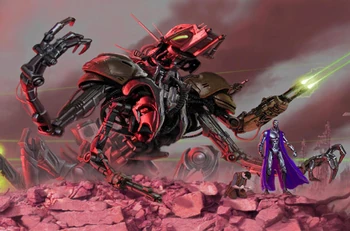
Thinking machines (a cymek and Erasmus) from the cover of Dune: The Machine Crusade (2003)
Thinking machines is a collective term for artificial intelligence in the Dune universe created by Frank Herbert. The Butlerian Jihad Template:Mdash a human crusade against thinking machines Template:Mdash is an epic turning point in the back-story of the Dune universe.[1][2] The thinking machines are first mentioned in 1965's Dune, and are adapted into autonomous robots to serve as the primary antagonists in the Legends of Dune prequel trilogy (2002–2004) by Brian Herbert and Kevin J. Anderson.
The original Dune series[]
The glossary of the novel Dune includes the following:
JIHAD, BUTLERIAN: (see also Great Revolt) — the crusade against computers, thinking machines, and conscious robots begun in 201 B.G. and concluded in 108 B.G. Its chief commandment remains in the O.C. Bible as "Thou shalt not make a machine in the likeness of a human mind."[1]
In Dune Messiah (1969), the Tleilaxu Face Dancer Scytale notes that "From the days of the Butlerian Jihad when 'thinking machines' had been wiped from most of the universe, computers had inspired distrust."[3]
Herbert refers to thinking machines and the Jihad several times in his later works in the Dune series, but does not give much detail on how he imagined either.[2] In God Emperor of Dune (1981), Leto Atreides II indicates that the Jihad had been a semi-religious social upheaval initiated by humans who felt repulsed by how guided and controlled they had become by machines:
"The target of the Jihad was a machine-attitude as much as the machines," Leto said. "Humans had set those machines to usurp our sense of beauty, our necessary selfdom out of which we make living judgments. Naturally, the machines were destroyed."[4]
Later in the same novel, Leto tests Siona Atreides, who experiences a vision of the future Leto is trying to prevent with his Golden Path. She witnesses mankind's extinction at the hands of "seeking machines":[5]
He knew this experience, but could not change the smallest part of it. No ancestral presences would remain in her consciousness, but she would carry with her forever afterward the clear sights and sounds and smells. The seeking machines would be there, the smell of blood and entrails, the cowering humans in their burrows aware only that they could not escape . . . while all the time the mechanical movement approached, nearer and nearer and nearer ...louder...louder! Everywhere she searched, it would be the same. No escape anywhere.[4]
Herbert's death in 1986 left this topic unexplored and open to speculation.[2]
Legends of Dune[]
Chronicling the Butlerian Jihad, the Legends of Dune series (2002–2004) by Brian Herbert and Kevin J. Anderson establishes that the thinking machines are a host of destructive robots led by Omnius, a sentient computer network. A thousand years before the Jihad, a group of twenty dissident humans had used thinking machines to enslave the rest of mankind, and then converted themselves into weaponized human-machine hybrids called cymeks. Essentially immortal and unstoppable, they had become known as the Titans, but after a century had been overthrown themselves by Omnius and made his servants. Mankind suffers under thinking machine oppression for another 900 years, before the murder of young Manion Butler at the hands of the independent robot Erasmus incites the Butlerian Jihad. The last remaining free humans, unified under the League of Nobles, fight for a century before finally defeating the machines in the Battle of Corrin.[6]
Hunters of Dune[]
In Hunters of Dune (2006), Brian Herbert and Kevin J. Anderson's first of a two-part finale to the original series, the antagonists Daniel and Marty (introduced in Frank Herbert's 1985 Chapterhouse: Dune) are revealed to be incarnations of Omnius and Erasmus. In the third Legends novel Dune: The Battle of Corrin (2004), Omnius had sent out a last burst of information before being destroyed in the Battle of Corrin; it is explained in Hunters that this signal had eventually connected with one of the probes disseminated from Giedi Prime several decades earlier, uploading versions of Erasmus and Omnius.[7]
References[]
- ↑ 1.0 1.1 Herbert, Frank (1965). "Terminology of the Imperium: JIHAD, BUTLERIAN". Dune.
- ↑ 2.0 2.1 2.2 MacDonald, Rod (January 6, 2009). "Review: Dune: The Butlerian Jihad by Brian Herbert & Kevin J. Anderson". SFCrowsnest.com. http://www.sfcrowsnest.com/articles/books/2009/Dune-The-Butlerian-Jihad-by-Brian-Herber--Kevin-J-Anderson--13987.php. Retrieved March 14, 2010. Cite error: Invalid
<ref>tag; name "SFC 2009-01" defined multiple times with different content - ↑ Herbert, Frank (1969). Dune Messiah.
- ↑ 4.0 4.1 Herbert, Frank (1981). God Emperor of Dune.
- ↑ Touponce, William F. (1988). "God Emperor of Dune". Frank Herbert. Boston, Massachusetts: Twayne Publishers imprint, G. K. Hall & Co.. p. 85. ISBN 0-8057-7514-5.
- ↑ Herbert, Brian; Kevin J. Anderson (2002-2004). Legends of Dune.
- ↑ Herbert, Brian; Kevin J. Anderson (2006). Hunters of Dune.
| |||||||||||||||||
es:Máquinas pensantes fr:Machines Pensantes (Dune) ru:Мыслящие машины